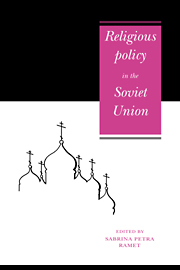Book contents
- Frontmatter
- Contents
- Notes on contributors
- Preface
- Part I Introduction
- 1 A survey of Soviet religious policy
- 2 Religious policy in the era of Gorbachev
- Part II Policy apparatus
- Part III Education, socialisation, and values
- Part IV Cults and sects
- Part V The world of Christianity
- APPENDIX: Religious groups numbering 2,000 or more, in the USSR
- Index
2 - Religious policy in the era of Gorbachev
Published online by Cambridge University Press: 03 December 2009
- Frontmatter
- Contents
- Notes on contributors
- Preface
- Part I Introduction
- 1 A survey of Soviet religious policy
- 2 Religious policy in the era of Gorbachev
- Part II Policy apparatus
- Part III Education, socialisation, and values
- Part IV Cults and sects
- Part V The world of Christianity
- APPENDIX: Religious groups numbering 2,000 or more, in the USSR
- Index
Summary
In May 1990, after some four years of discussion and delay, the draft of a new law on religious organisations was read to the USSR Supreme Soviet. It was passed into law on 26 September 1990. Initially intra-elite disagreement was said to have accounted for repeated delays. But the delays also had a propitious side-effect, in that they allowed the Gorbachev regime to make incremental changes in de facto religious policy, without making the changes official, de jure, all at once. In this way, changes in practice helped to prepare the way for changes in legislation. As passed, the law granted religious organisation full legal status, permitted religious education in public schools (after regular school hours), allowed religious organisations to own their places of worship and other property, allowed them to import literature from abroad and to engage in charitable activity, and equalised the tax structure for clergy (which had previously been higher than for ordinary citizens). It also guaranteed freedom of worship, forbade the government to interfere in religious activities, and ended the seventy-year-old policy of officially backed atheism, proscribing discrimination on the basis of religious belief. In fact, under the new law, the government was barred from financing either atheist work or religious activities. Religious property rights were also guaranteed in a new Soviet law on property ownership, the draft text of which was published in Pravda in November 1989. Article 21 dealt with the property of religious organisations and specified:
Religious organizations may own buildings, religious objects, production and social facilities, charitable operations, money, and other assets essential to their activities.
- Type
- Chapter
- Information
- Religious Policy in the Soviet Union , pp. 31 - 52Publisher: Cambridge University PressPrint publication year: 1992

